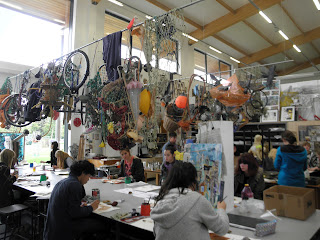Skill
Development
Evaluation
Essay
Before I started my Media AS course in my first
year of college, I had minimal technical skills and knowledge in terms of the
media business and computer technology. I roughly used Photoshop and Flash
player in the media course, so I was able to edit images, using tools like tone
and colour adjustments, blur and warp, and create a short animation on Flash.
The entire course was course work, and the majority being assignments on
Microsoft Word and PowerPoint, so creative work was at a minimum, as it mainly
consisted of research on Media products, like CD’S and DVD’s, methods of
producing such as printers or sounds recording studios, and some work on record
labels. Since that course, in college my skills on Photoshop have vastly
improved, and the scale and variety of my work has widened and improved my
knowledge and skills in Media.
My foundation portfolio task was to create a front
cover and contents page of a college magazine about college life, sports,
subjects etc.

This is my college magazine front cover,
and my first extensive creative project on Photoshop. I went through about
three drafts to get to this final product, gradually improving it over time. Rays
lessons on how to use Photoshop reminded me of what I knew previously, and
taught me allot more, being able to use the tools and effects more
professionally and precisely. One feature I learned was to edit layers by using
‘Blending Options’ when you right click on the layer. Using this, I was able to
highlight the writing in white (Wyke) and give the writing a more bold,
standing out – 3D effect, such as the website at the bottom of the page. The
image of the student on the front cover was the first image I had taken of
anyone in order to use it in a product. Unfortunately, I had not taken the
lighting into account, and the image as a result looks out of place and too
bright for the background. This mistake would later help with my image in music
magazine.

The contents page of my magazine includes
allot more images. Being able to have access to a camera and go around the
college taking pictures gave me allot of experience in photo taking. In year 11
media I had used a video camera and still camera before, but this time required
the images to be of better quality, and to be edited later in Photoshop. I also
used the ‘Blending Options’ to create the shadow effect on the image boxes in
the bottom right, the increased the transparency of the text box in front of
the image at the top of the page. By making the fonts and borders curvy and
cartoonish, I tried to give the magazine image a fun and light hearted tone,
and this work helped me with the methods on how to create a consistent and
particular house style.
The music magazine task was to create a front
cover, double page spread and contents page of a music magazine, in a genre and
style of my choice. I chose alternative music as my genre.

This is the front cover for my music
magazine. I carried on the same font and house style from the college magazine,
except with the main colour being blue. I used more effects on Banner Headline
with this cover, by additionally using ‘Edit’, ‘transform’ and ‘distort’ to
make the ‘Fuse’ bulge outwards. With this magazine, I researched NME and used
it as my inspiration, and tried to create a more professional and detailed
magazine, by including more conventions that a music magazine would. I expanded
the Masthead by giving it subtitles, including ‘THE UK’s HOTTEST NEW MUSIC
MAGAZINE’, and added straplines around the Banner Headline. The image is far
better quality, cut out and fitting with the rest of the page, so from the
mistake of my image on my college magazine, I learned how to appropriately take
photographs effectively.


I used my skills in photography and editing to try
and produce as detailed and quality contents page as I could. Additionally, the
layout and structuring of the page is quite complex, so that also improved my
skills of structuring a page. The contents and double page spread was the first
time I would write my own fictional articles in a journalistic form. The double
page is in typical form, with the image on the right, and the written article
on the left. From my research of real magazines, I picked up this type on
conventional layout.
My research and planning included genre, audience,
price and LIIAR analysis of magazines. The genre research helped me identify my
own creative product, and what other magazines of the same genre would feature,
including Q Magazine and NME magazine. This helped me identify and audience,
and the Demographics and Psychographics helped me identify specifically who my
magazine would appeal to. The LIIAR analysis’ improved my skills of analysis,
more specifically, what details I should be concentrating on when analysing a
magazine. However, I did find the amount of analysis daunting, so for the
future, my time will be managed better when it comes to analysis. My planning
could have been more thorough and so next time I know to concentrate harder
onto extending my planning and research.
The developments in my skills in Photoshop,
creative writing and photography have really helped me understand the process
of creating magazines, and I will carry on those skills onto my future work in
Media. I enjoyed the creative writing part of the task the most as I could
write out an article in my own style, which allows me to be creative in that
sense. I feel much more confident now in creating products such as these
because I know I have created quality products previously.












































